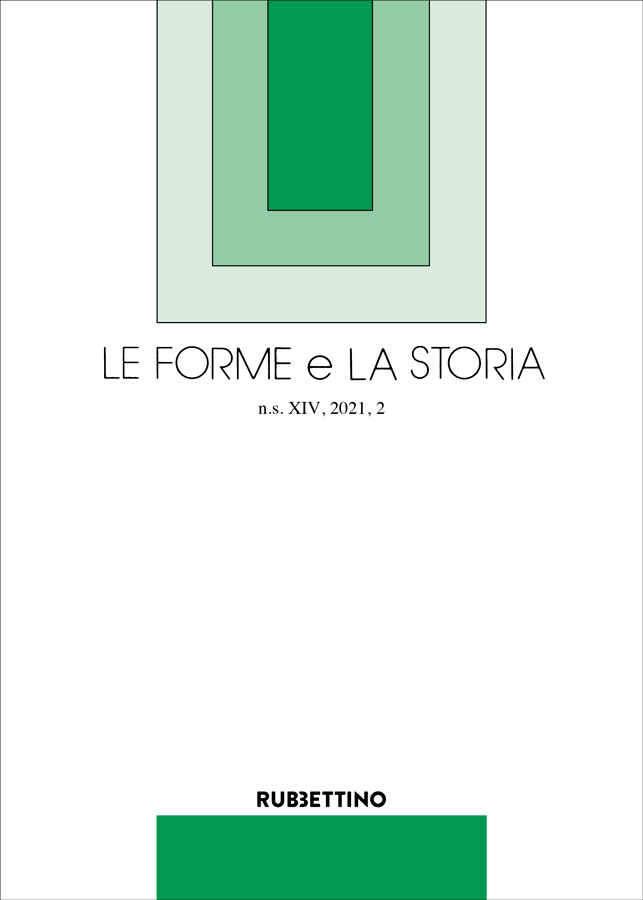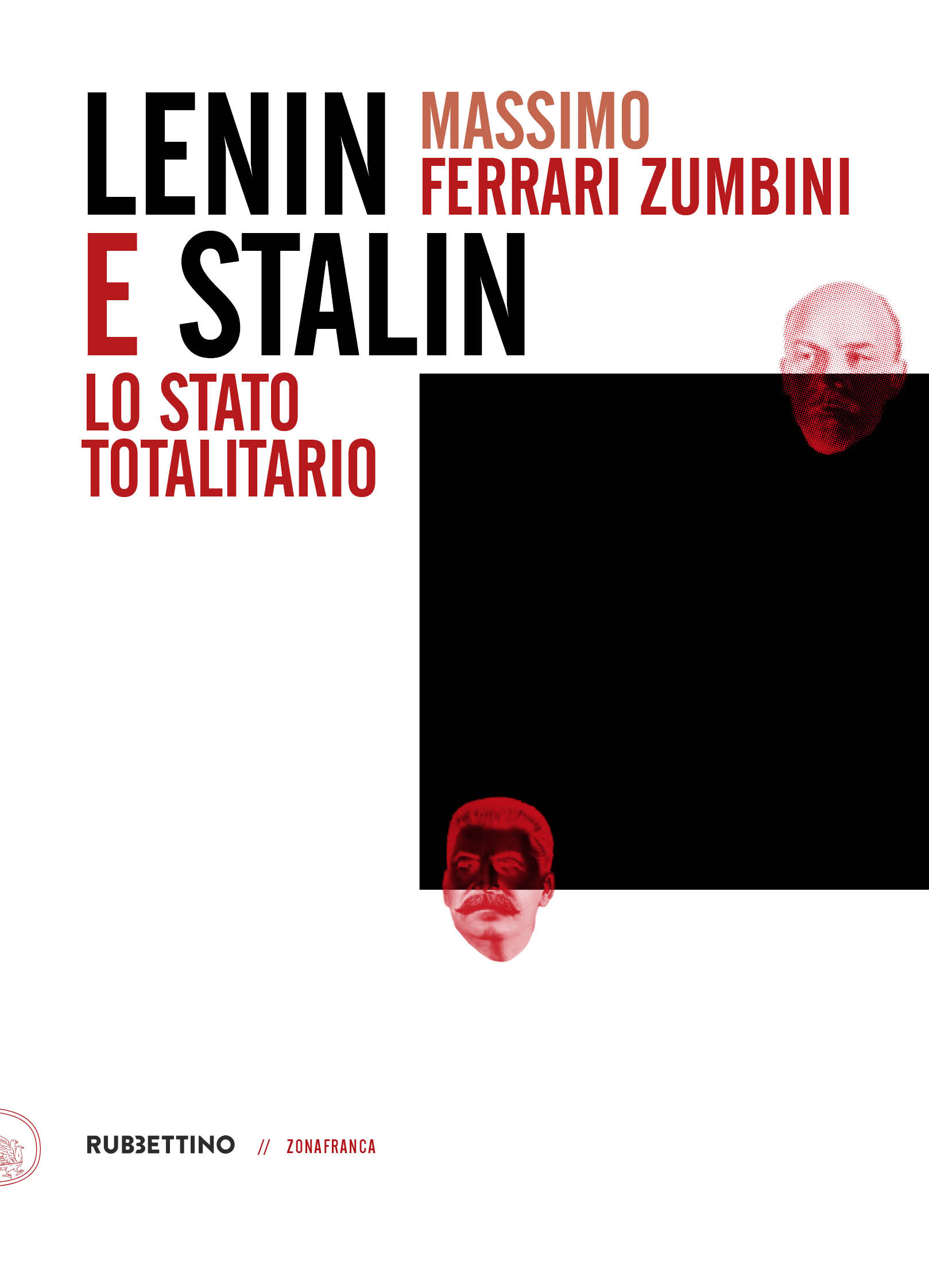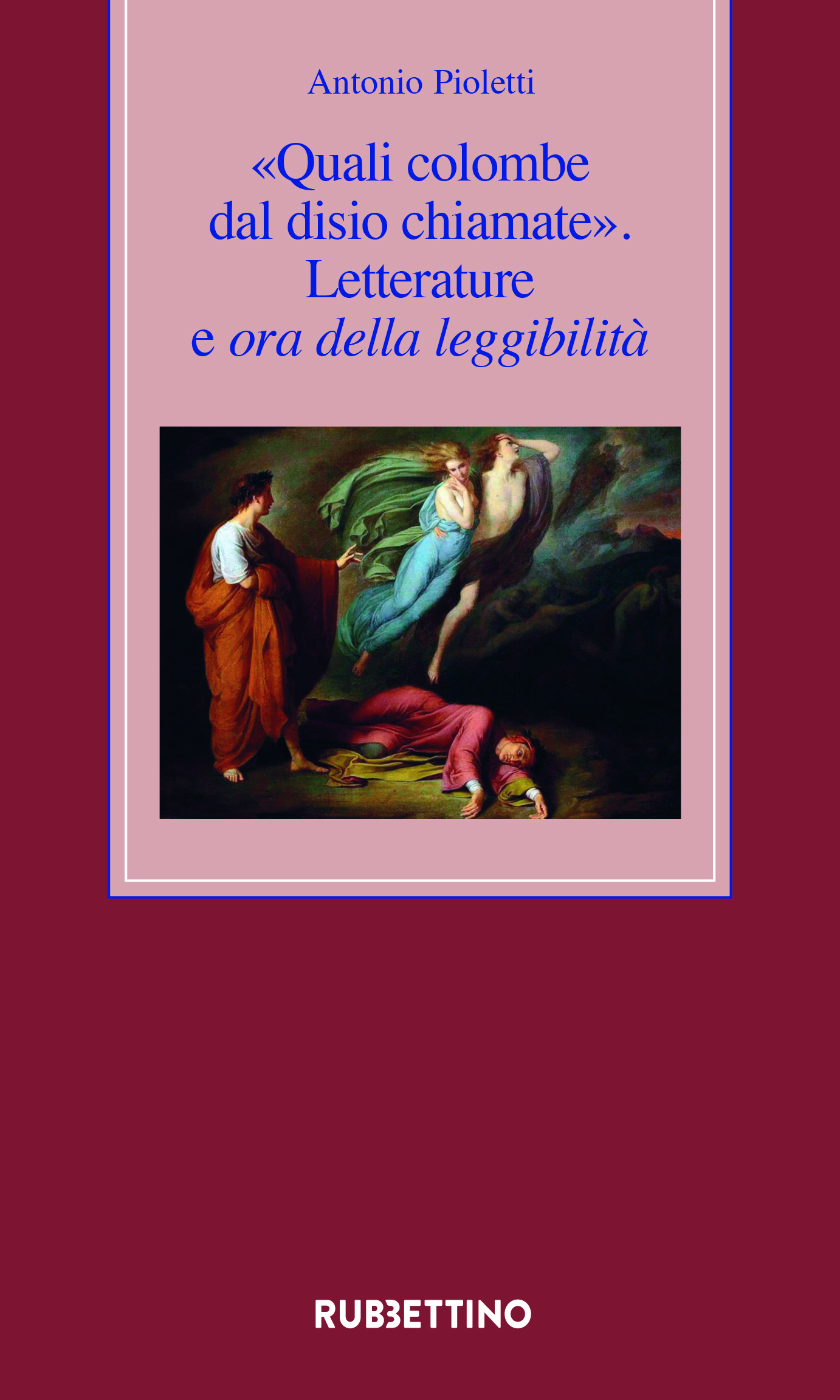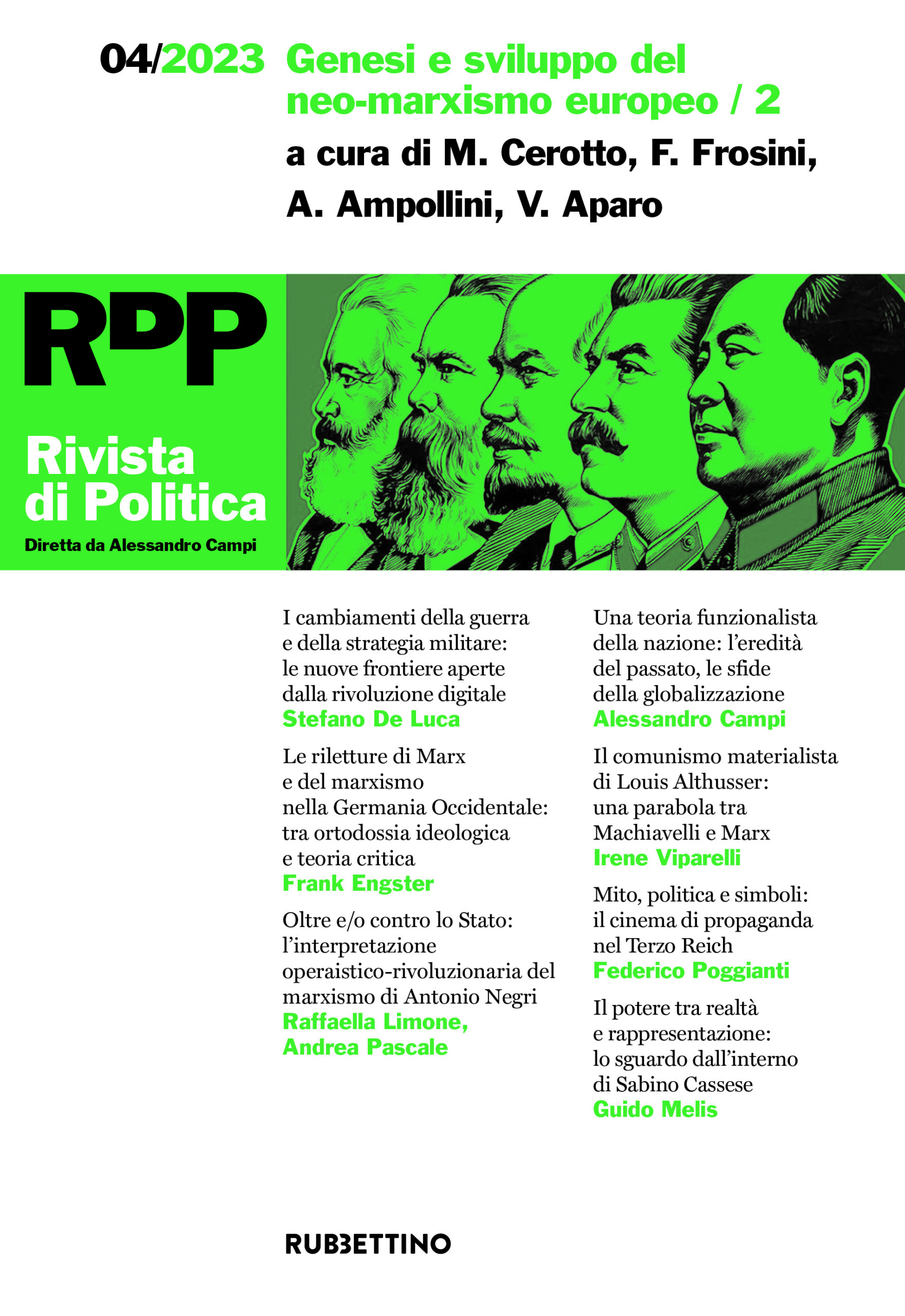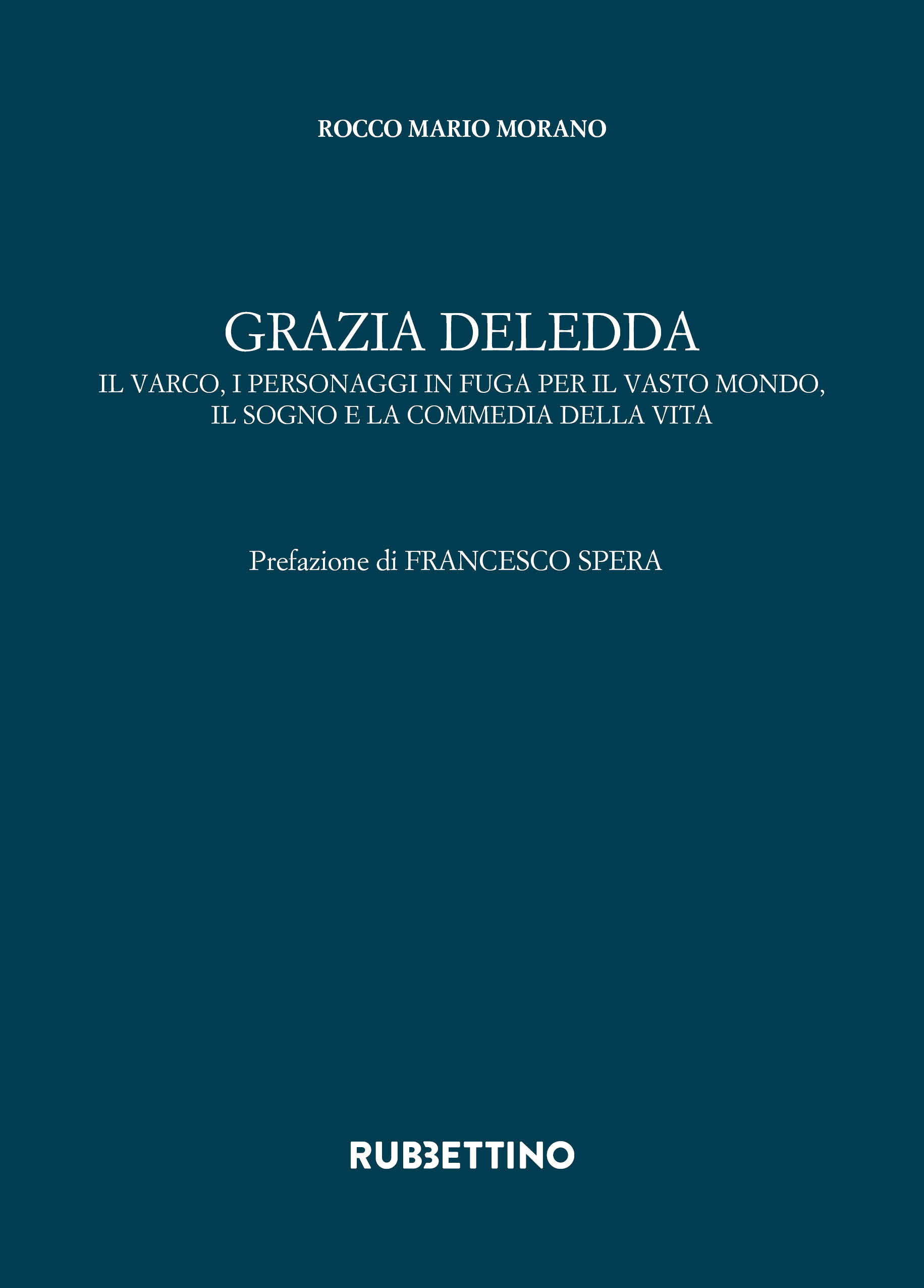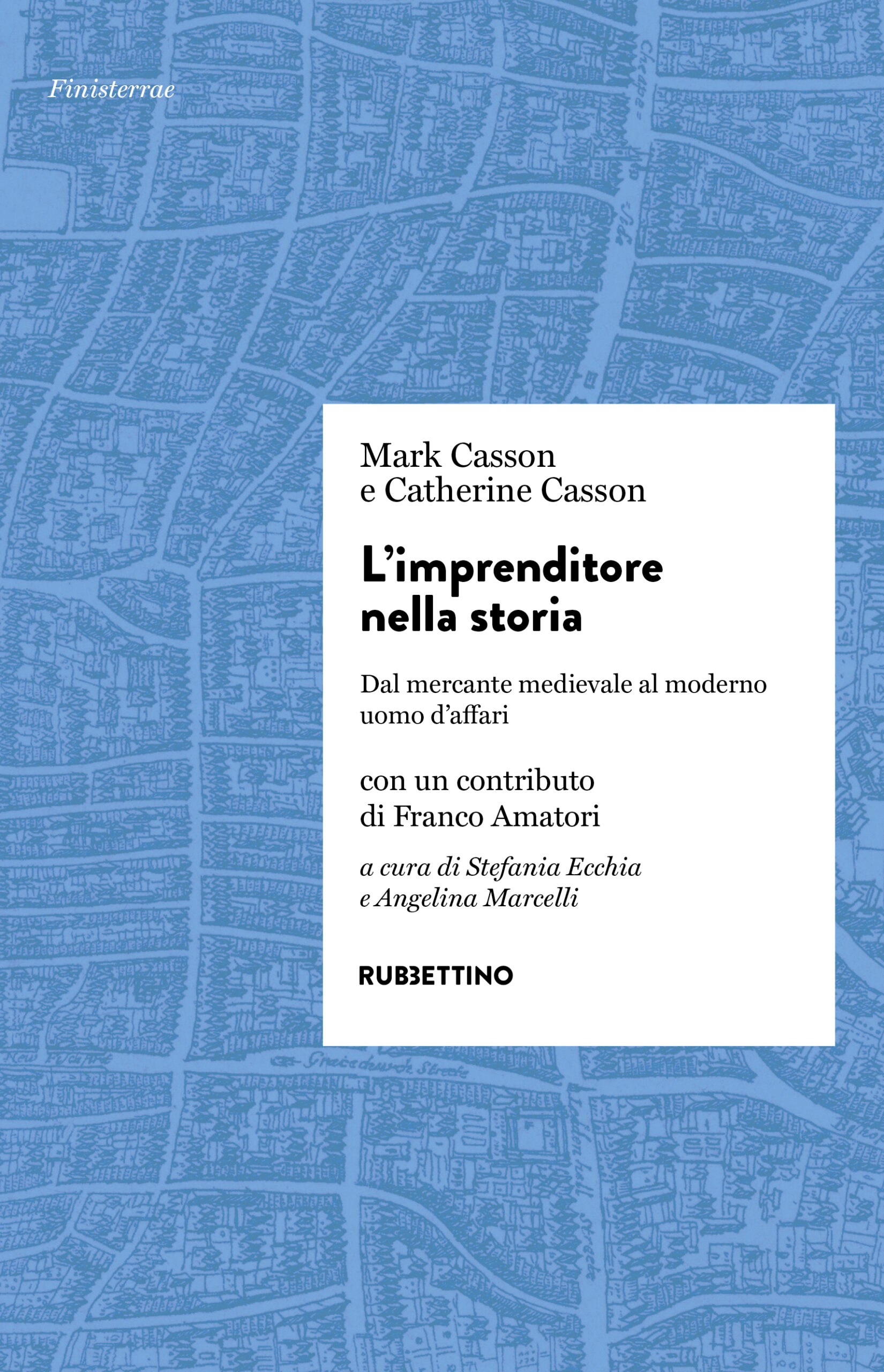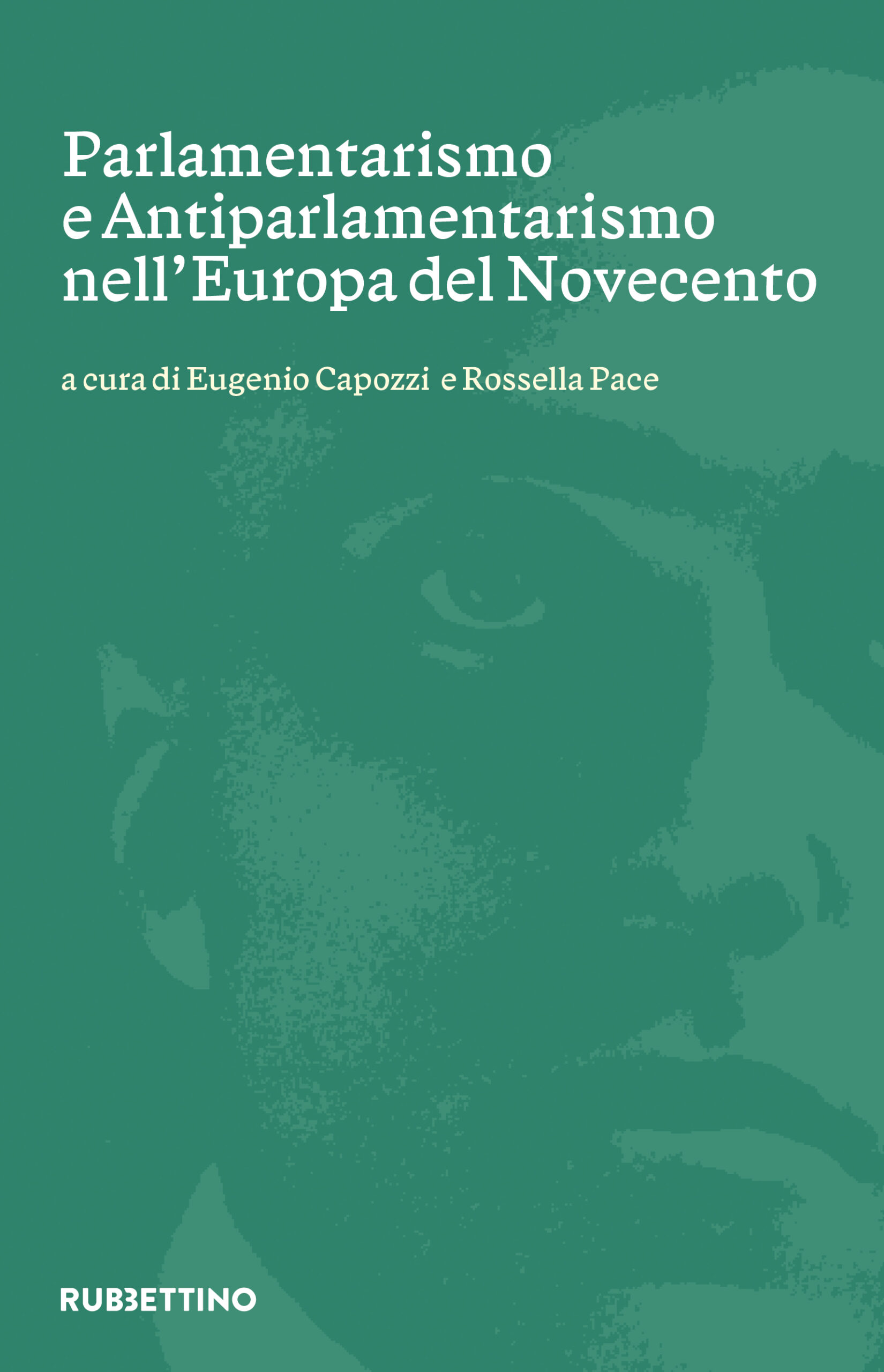Le forme e la storia ns XIV, 2021, 2
Cartaceo
€14,25 €15,00
Premessa
Nicolò Mineo e Antonio Pioletti
A Marilia Marchetti
Antonio Gurrieri
Profilo scientifico di Marilia Marchetti
Maria Luisa Scelfo
Segreti di famiglia: il primo romanzo di Marilia Marchetti
Saggi
Mirella Cassarino
Empatia o parodia in un’epistola di Ibn
Premessa
Nicolò Mineo e Antonio Pioletti
A Marilia Marchetti
Antonio Gurrieri
Profilo scientifico di Marilia Marchetti
Maria Luisa Scelfo
Segreti di famiglia: il primo romanzo di Marilia Marchetti
Saggi
Mirella Cassarino
Empatia o parodia in un’epistola di Ibn al-S.abbāg˙ al-S. iqillī ad Abū H. afs. al-Qa‘īnī
Oggetto del mio contributo è l’analisi dei frammenti di un’epistola, fino a oggi mai studiata, che è parte di uno scambio di lettere di area maghrebina in prosa rimata, ascrivibile alla prima metà dell’XI secolo, a noi pervenuto tramite la Dˉah˘īra fī mah. āsin al-Gˇ azīra del poeta e antologista Ibn Bassām (m. 1147). Gli autori delle lettere, che presentano peculiari declinazioni del tema amoroso, sono l’andaluso Abū H. afs. al-Qa‘īnī e il siciliano Ibn al-S. abbāg˙, probabilmente legati da una sincera e profonda amicizia (Cassarino 2015). I frammenti in questione consentono di mettere in evidenza, da un canto, i topoi del carme amoroso utilizzati da al-Qa‘īnī e, dall’altro canto, al di là della lepidezza lubrica e salace, quasi goliardica, gli elementi di carattere umoristico ai quali Ibn al-S. abbāg˙ fa ricorso per consolare l’amico affranto per la perdita della schiava amata.
The aim of my contribution is the analysis of the fragments of an epistle in rhymed prose, never studied until today, which is part of an exchange of letters from the Maghreb area, ascribable to the first half of the 11th century. It came to us through the D ˉ ah ˘īra fī mah. āsin al-Gˇ azīra by the poet and anthologist Ibn Bassām (d. 1147). The authors of the letters, which present peculiar declinations of the love theme, are the Sicilian Ibn al-S. abbāg˙ and the Andalusian Abū H. afs. al-Qa‘īnī, probably linked by a sincere and deep friendship (Cassarino 2015). The fragments in question allow us to highlight, on the one hand, the topoi of the love poetry used by al-Qa‘īnī and, on the other hand, beyond the lewd and salacious, almost goliardic lepidity, the humorous elements to which Ibn al-S. abbāg˙ resorts, in order to console his friend who is afflicted by the loss of his beloved slave.
Antonio Pioletti
Alterità arturiane nel processo di formazione del romanzo
Come rilevato da Alberto Varvaro, il romanzo medievale inizia «con adattamenti di materia antica e con la leggenda di Tristano e Isotta. […] le vicende narrate si collocano in tempi, luoghi e società ‘altri’ rispetto alla contemporaneità delle corti francesi e anglonormanne del XII secolo». Antonio Pioletti qui prende in esame come l’alterità è rappresentata nel romanzo arturiano: il nesso finzione-realtà; l’elemento meraviglioso; lo straniero; i diversi gruppi sociali. L’autore infine rileva i tratti formali che collocano quelli arturiani all’interno del processo di formazione del romanzo.
As pointed out by Alberto Varvaro, the Medieval romance begins «with adaptations of classical material and with the legend of Tristan and Isolde» […] the events narrated sit within times, places and societies that are ‘other’ with regard to the contemporary world of the French and Anglo-Norman courts of the twelfth century.. Antonio Pioletti here examines how alterity is represented in the Arthurian romance: the fiction-reality nexus; the element of wonder; the outsider; the various social groupings. The author then traces the formal features that place the Arthurian romances within the process of development of the novel.
Gaetano Lalomia
Il lessico erotico nel Roman des sept sages de Rome
Attraverso una disamina del lessico erotico del Roman des sept sages si perviene all’idea che la sfera propriamente legata all’eros della narrativa medievale ricorre a un linguaggio variegato ma pur sempre di carattere metaforico. Tale caratteristica è presente in qualsiasi tipo di narrazione, senza distinzione di genere. Ciò che la ricerca mette in evidenza è la diffusione di una serie di lemmi che trovano consistenza in vista delle circostanze narrate.
A discussion of the erotic lexicon in the Roman des sept sages makes it possible to observe that the description of eros in medieval romance fiction relies on metaphorical language. The pertinence of specific words in the context of the narrative makes the lexicon consistent, independently of the genre to which the literary works actually belong.
Paula Viljanen-Belkasseh
The Image of Italians in Finnish Travelogues of the 19th Century
Questo articolo studia le descrizioni degli italiani da parte dei viaggiatori finlandesi nei resoconti di viaggio della seconda metà del XIX secolo. L’analisi è fatta da un punto di vista imagologico, cioè, si concentra sull’esame delle espressioni letterarie delle immagini dell’“Altro” italiano in relazione al “Sé” finlandese. In questo modo l’analisi si collega ai precedenti studi imagologici sulla letteratura di viaggio che ha per oggetto l’Italia e gli italiani.
This paper studies Finnish travellers’ descriptions of Italians in the travelogues of the second half of the 19th century. The analysis is conducted from an imagological point of view, that is, it concentrates on examining the literary expressions of the images of the Italian ‘Other’ in relation to the Finnish ‘Self ’. By doing so, the analysis forms a link to the previous imagological studies regarding travel literature that has as its object Italy and Italians.
Andrea Manganaro
«La più bella storia letteraria che sia stata mai scritta»: la Storia di Francesco De Sanctis
In A History of Modern Criticism, René Wellek ha definito la Storia della letteratura italiana di Francesco De Sanctis «la più bella storia letteraria che sia stata mai scritta». Tutt’altro che compiaciuta celebrazione della tradizione letteraria, la storia della letteratura costituiva per De Sanctis un momento della ricostruzione storiografica della storia della nazione, il cui telos tendeva a collocarsi nel presente, nel processo risorgimentale di unificazione nazionale che egli vedeva giungere a compimento mentre scriveva. La sua Storia non era solo una narrazione del passato, ma anche coscienza riflessa del presente, istanza di un ulteriore e generale rinnovamento dell’Italia.
In A History of Modern Criticism, Ren. Wellek called Francesco De Sanctis’ History of Italian Literature .the most beautiful literary history ever written». Far from being a smug celebration of the literary tradition, the history of literature constituted for De Sanctis a moment of the historiographical reconstruction of the history of the nation, whose telos tended to place itself in the present, in the Risorgimento process of national unification that he saw coming to completion while he wrote. His history was not only a narration of the past, but also a reflected awareness of the present, an instance of a further and general renewal of Italy.
Marina Paino
L’‘uomo-altro’ di Montale: sondaggi lessicali e attraversamenti concordanziali
Lo studio ricostruisce con metodo concordanziale la presenza, all’interno del corpus lirico montaliano, di riferimenti a figure di uomini-altri, estranei al sentire del poeta e rappresentati sin da Ossi di seppia come autentici ‘altro’ da lui. Il pedinamento concordanziale di questo indistinto personaggio mette tuttavia in evidenza come da Satura in poi la distanza tra questi e l’io lirico risulti progressivamente sfumata, in linea con il mutamento di prospettiva che segna tutta la stagione del ‘verso’ che segue al ‘recto’ dei versi montaliani.
Through concordance reading, the study reconstructs the presence, within the Montale poetry corpus, of references to other-male figures; figures alien to the poet’s feeling and that have been represented since Ossi di Seppia as authentically ‘other’ than him. The concordance search for this indistinct character highlights nonetheless how, from Satura onwards, the distance between the lyrical subject and the character is more and more blurred, in line with the change in perspective marking the season of the ‘verso’ preceding the ‘recto’ in Montale’s lines.
Alterità, comparatismo, contaminazioni. Linee di francesistica
Antonio Gurrieri
La ville de Lyon: imaginaires touristiques et discours
La ville de Lyon se pr.sente aux touristes comme la capitale de la gastronomie française et comme une ville historique, avec son quartier de style Renaissance. Toutefois, une nouvelle image s’impose ; celle d’une ville moderne, en perpétuelle évolution. Notre étude vise à analyser les proc.d.s énonciatifs et discursifs qui permettent d’édifier un imaginaire de savoir partagé. Il autorise la découverte d’un lieu historique d.j. connu et permet de jeter les bases pour la description de la modernité.
The city of Lyon shows itself to tourists as the capital of French gastronomy but especially as a historic city with its Renaissance style district. However, a new image makes its way, that of a modern city in continuous evolution. From the discursive point of view, our study aims to analyse the enunciative and discursive processes that allow to construct an imaginary of shared knowledge through which we can lay the foundations to describe modernity.
Annafrancesca Naccarato
L’autre dans la langue. Sur la poésie de Lorand Gaspar
Cet essai se propose de montrer que, dans la poésie de Lorand Gaspar et, en particulier, dans l’une des sections d’Egée, la métaphore vive constitue un instrument privilégié pour tisser la trame d’une écriture qui vise . ouvrir une bréche au sein de catégories pr.constitu.es et . transmettre une vision dynamique du sens, qui échappe au domaine des concepts organisés. En se configurant comme l’issue d’une d.marche interprétative que suscite la mise en forme linguistique d’un contenu complexe contradictoire, la figure témoignedu pouvoir de la langue de créer des connexions signifiantes indépendamment des solidarités entre contenus qu’établissent les structures de la pens.e cohérente. C’est ainsi que, centrée de par sa nature m.me sur le transfert d’un concept dans un domaine «tranger, elle permet . l’autre, l’autre de la langue, de dépasser les frontiéres qui le s.parent du propre et de devenir le protagoniste non pas d’un processus d’exclusion ou de marginalisation, mais – au contraire – d’une interaction féconde et vivifiante.
The present essay aims to show that in Lorand Gaspar’s poetry ‒ in particular, in a section of .g.e – the living metaphor is a privileged tool to weave the thread of a writing that intends to open a breach within pre-established categories, thus conveying a dynamic vision of meaning which escapes the sphere of organized concepts. Being the outcome of an interpretative process raised by the linguistic shaping of a complex contradictory content, the figure testifies to the power of language to create meaningful connections not depending on the links between contents established by coherent thought structures. Since it is based by its very nature on the transfer of a concept into a foreign domain, the figure allows the other ‒ i.e. the “other” of language ‒ to go beyond the borders that separate it from the “own” and to become the protagonist not of a process of exclusion or marginalization but of a fruitful and life-giving interaction.
Yannick Preumont
L’aventurier et le rêve oriental dans L’Argent d’Émile Zola. Une approche traductologique
Dans cette étude, nous d.fendons l’id.e que la traductologie permet d’approfondir la question de la r.ception d’.mile Zola en Italie. Comment les lecteurs italiens per.oivent-ils l’auteur de L’Argent (1891) et son personnage principal Saccard, .ce forban du pav. de Paris, br.l. et tann. dans tous les guets-apens financiers.? Plus que l’approche analytique des d.bats concernant les concepts de malhonn.tet. et de haute finance, c’est la description des principaux probl.mes qu’ont d. affronter les traducteurs qui nous intéresse ici. Nous d.crivons bri.vement le “reve oriental” de Saccard et les techniques choisies par les quatre traducteurs italiens. Les textes .tudi.s, publi.s pour la premiére fois en 1891 (traducteur anonyme – Treves), 1904 (Edmondo Corradi), 1996 (Luisa Collodi) et 2017 (Fabio Grassi), proposent des approches différenciées pour la description de Saccard et de son fils Victor. Nous les analysons dans le but de mettre en .vidence quelques caractéristiques linguistiques et quelques “figures de traduction” bien intéressantes. Nous poursuivons ici nos recherches traductologiques sur les sagas familiales européennes, un domaine à la fois familier et exotique dont .mile Zola reste un des maitres incontestés.
In this study, I support the claim that the practice of translation can help us to approach in an original way the reception of .mile Zola in Italy. This article adresses how the Italian readers perceive the French author of L’Argent (Money – 1891) and his famous “Buccaneer” Saccard. It does not have as its purpose the analytical delineation of the debates concerning the concepts of finance and dishonesty, but rather the description of the current problems encountered to convert Zola’s work into another language. We briefly describe the “Oriental Dream” of Saccard and the translation techniques used by four Italian translators. The texts studied, published for the first time in 1891 (anonymous translator – Treves), 1904 (Edmondo Corradi), 1996 (Luisa Collodi) and 2017 (Fabio Grassi), show different approaches for the description of Saccard and his son Victor. We analyse them in order to highlight some specific linguistic characteristics and “figures de traduction”. As a result, this article’s conclusion calls for a comparatism that seeks an answer to the question who translates what and how in the domain, so exotic and familiar at the same time, of the Family Novel.
Francois Proia
Il cinema surrealista. La realtà così come la vediamo e le immagini occulte dell’inconscio
Sebbene i surrealisti fossero molto affascinati da questo medium espressivo, e sebbene la pittura, il cinema, e in generale le arti visuali, fossero diventate, anche a livello teorico, un canale privilegiato per l’affermazione dell’arte surrealista, i soli film, del periodo tra le due guerre, concepiti e realizzati da un regista surrealista e conformemente ai principi artistici surrealisti, sono Un Chien Andalou e L’Age d’Or di Buñuel. Questi film non danno, tuttavia, una risposta definitiva su cosa sia il cinema surrealista, ci dicono solo cosa è stato prodotto all’interno del Surrealismo, senza contare i film che possono essere situati in una dimensione periferica ad essi, e soprattutto non sono sufficienti a rendere chiaro come avvicinare un film alla sensibilità surrealista.
Although the Surrealists were very fascinated by this medium of expression, and although painting, cinema, and the visual arts in general, had become, even on a theoretical level, a privileged channel for affirmation of surrealist art, the only films, from the period between the two wars which were designed and produced by a surrealist director, and in accordance with surrealist artistic principles, are Un Chien Andalou and L’.ge d’Or by Bu.uel. But this circumstance does not even give a definitive answer on what surrealist cinema is, it only tells us what was produced within Surrealism, not to mention the films that can be located in a peripheral dimension to it, and above all it is not enough to make it clear to bring a film closer to surrealist sensibility.
Cettina Rizzo
L’invenzione dell’Oriente: immaginari, rappresentazioni, contraddizioni da Delacroix e Tahar Ben Jelloun
In questo saggio si mettono a confronto i Souvenirs d’un voyage dans le Maroc di Delacroix e La Lettres . Delacroix di Tahar Ben Jelloun, al fine di analizzare, nel vasto ambito degli studi sull’‘Orientalismo’, una complessa relazione interculturale che ha radici antiche e ricadute contemporanee. Le diverse tipologie di documenti, da quelli iconografici a quelli autentici e di finzione, rendono conto della costruzione di un immaginario falsato ma anche di una feconda dialettica dell’alterità.
In this essay we compare Delacroix’s Souvenirs d’un voyage dans le Maroc and Tahar Ben Jelloun’s Lettres . Delacroix, in order to analyze, in the vast field of ‘Orientalism’ studies, a complex intercultural relationship that has ancient and contemporary relapses. The different types of documents, from iconographic to authentic and fictional ones, account for the construction of a falsified imaginary but also for a fruitful dialectic of otherness.
Claudia Scandura
Tiflis a Parigi: Il’ia Zdanević e Coco Chanel
L’articolo presenta l’attività artistico-letteraria di Il’ja Zdanevič (Iliazd) dagli esordi in Russia, a Parigi, dove il poeta e illustratore arrivò nel 1921. Nella capitale francese si trovava una folta comunità di artisti emigrati dopo la rivoluzione di Ottobre. Grazie all’aiuto della pittrice di origine ucraina Sonia Terk-Delaunay, Iliazd iniziò a lavorare come disegnatore tessile e entrò in contatto con Coco Chanel. Successivamente fu nominato direttore della fabbrica Chanel Tissues, dove introdusse il telaio georgiano per la lavorazione del jersey. I tipici disegni geometri della casa di mode Chanel sono ispirati ai dipinti dell’avanguardia russa e furono ideati da lui.
The paper discusses Ilya Zdanevich’s activity in Russia and in Paris where the poet and illustrator came in 1921. There he met many Russian artists he already knew from Moscow, who went to Paris after the October Revolution. With Sonia Terk-Delaunay’s help, he began to work as designer in a Factory that was later purchased by Coco Chanel. He was appointed design director of Chanel Factory, where he introduced Georgian loom. Typical Chanel pattern are oriented on Russian avant-garde paintings and were designed by him.
Carminella Sipala
Medea barbara e crudele in guerra con il mito
The name of Medea and the tragic events that mythology associates to this character attract implacably authors of the 19th and 20th century. On the tragic scene, but also in the vaudeville, in the bourgeois drama and in other non-theatrical genres, horror is relentlessly renewed. A reflection on the reasons behind this constant interest is necessary, as well as a consideration of the forms taken by rewriting during these two centuries. The quest of a possible «originalité dans l’imitation» becomes investigation into the representation of female criminality and of femininity as a crime.
Le nom de M.d.e et les vicissitudes tragiques que la mythologie associe à ce personnage attirent d’une façon irrésistible les auteurs du XIXe au XXe siècle: sur la scéne tragique, mais aussi dans le vaudeville, dans le drame bourgeois et dans d’autres genres littéraires non théatraux, l’horreur se renouvelle sans reléche. Il faut donc réfléchir sur les motivations de cet int.r.t constant et aussi sur le formes des réécritures produites tout au cours de ces deux siécles. La recherche de la possibilité d’une «originalité dans l’imitation» devient ainsi une enquete sur la construction d’une image de la criminalité féminine et de la féminité comme crime.
Il nome di Medea e le tragiche vicende che la mitologia associa a questo personaggio attirano inesorabilmente gli autori del XIX secolo e poi del XX secolo: sulla scena tragica, ma anche nel vaudeville, nel dramma borghese e in altri generi non teatrali, l’orrore implacabilmente si rinnova. Si impone dunque una riflessione sulle ragioni di tale costante interesse e insieme sulle forme delle riscritture che questi due secoli hanno prodotto. La ricerca di una possibile «originalité dans l’imitation» diventa così indagine sulla costruzione dell’immagine della criminalità femminile e della femminilità come crimine.
Gisèle Vanhèse
«Sur la crête des ténèbres». Le mythe du vampire et la Roumanie dans l’oeuvre d’Alexandre Dumas
Au XIXe siècle, le vampire devient véritablement l’autre de la soci.t. moderne occidentale, qui l’léoigne par un processus de distanciation complexe. Nous voudrions montrer que, bien avant Dracula de Bram Stoker, Alexandre Dumas avait déjà créé, dans La Dame p.le (1849), un double paradigme symbolique (folklorique et littéraire). En effet, le vampire de ce r.cit n’est plus un dandy cosmopolite et citadin, mais un seigneur hors-la-loi qui doit beaucoup aux légendes et aux croyances de la Roumanie. La figure vampirique unit cette influence, issue du folklore le plus profond, . celle de la littérature romantique, en particulier pour la représentation de la beaut. masculine fatale et ténébreuse.
In the Twentieth Century the vampire becomes the true other of modern occidental society, a society that casts him out in a process of complex distancing. We would like to demonstrate that, well before Bram Stoker’s Dracula, Alexandre Dumas had already created, in La Dame p.le (1849), a twofold symbolic paradigm (folkloric and literary). In effect, the vampire of this story is no longer a cosmopolitan dandy, but an out-law who owes much to the legends and beliefs of Romania. The vampire figure unites this influence, welling up from the deepest folklore origins, to that of Romantic literature, in particular the representation of masculine beauty, both as fatal and dark.
Claudio Vinti
Jean-Luc Godard retore e linguista
Amato e odiato da pubblico e critica in modo speculare, per Godard si è parlato di regista «scrittore», «pittore», «filosofo», «storico», «sociologo» e «poeta», ma nessuno di questi appellativi è riuscito a definire compiutamente la personalità creatrice di questo «enfant terrible» del cinema contemporaneo, tanto inventivo quanto insolente, rivoluzionario della prima ora, che, alla soglia dei novant’anni, riesce ancora a sorprendere. In questo articolo voglio parlare di Godard «linguista», visto l’interesse che il regista ha sempre dimostrato nei confronti del linguaggio e della parola. Un interesse ribadito in Adieu au langage (2014) e nel recentissimo Le Livre d’image (2019). In particolare, sorprende nel cinema di Godard, l’utilizzo delle figure di stile letterarie che diventano figure di stile cinematografiche di cui il regista si serve per comunicare più efficacemente con il pubblico. Nel cinema di Godard, il campionario di queste figure è vastissimo: dalla «massima» all’ «aforisma», al «paradosso», fino all’«allusione», al «blasone letterario», alla «disputa amorosa», all’«anacoluto», e soprattutto alla «tautologia».
Audiences and critics are equally divided in their love and hate for Godard. From time to time the director has been defined: «writer», «painter», «philosopher», «historian», «sociologist» or «poet», but none of these names can fully define the creative personality of this «enfant terrible» of contemporary cinema, as inventive as it is insolent, a revolutionary who is still able to amaze on the threshold of his nineties. In this article I want to talk about Godard as a «linguist», given the interest that the director has always shown towards language and words; a renewed interest shown in «Adieu au langage» (2014) and in the very recent «Le livre d’Image» (2019). In particular, in Godard’s cinema the use of literary-figures that become cinematographic-figures that the director uses to communicate more effectively with the public is surprising. In Godard’s cinema, the sample of these figures is vast: «maxim», «aphorism», «paradox», «allusion», «literary emblem», «love dispute», «anacoluthon», «tautology» and others.
Interventi e discussioni
Veronica Benzo
La recherche de l’Autre et le respect de la diversit. dans la communication interculturelle professionnelle: le contexte des entreprises
Aujourd’hui, l’Autre est omnipr.sent et les individus se retrouvent de plus en plus à se relationner avec d’autres cultures. La coexistence et la cohabitation entre professionnels de cultures diff.rentes demandent de trouver des solutions aux conflits culturels qui se manifestent dans les relations de travail, et cela . cause de l’accroissement du nombre de négociations commerciales dans une soci.t. qui est devenue globale. L’altérité culturelle se manifeste dans toutes les formes de communication interne ou externe à l’entreprise et tous les acteurs impliqués doivent etre toujours à l’écoute de l’Autre: à l’interne il s’impose le management interculturel; à l’externe, lorsqu’ il faut transférer l’identité d’une marque (culture d’entreprise) par la publicité, il faut savoir adapter son message à la cible visée, à travers des stratégies de communication adéquates.
Nowadays, the concept of Otherness is everywhere and individuals find themselves relating to different cultures. The coexistence and cohabitation between professionals of different cultures demand that solution be found to cultural conflicts which emerge in workplace relationships, given the increase in the number of trade negotiations in a society which has become global. Cultural otherness is present in all forms of communication both inside and outside a company and all the actors involved must be ever attentive to Otherness: within the firm intercultural management is imposed; externally, when it is necessary to transfer the identity of a brand (business culture) through advertising, its message must be carefully adapted to the target audience, using adequate communication strategies.
Elisabeth Grimaldi
Le RAP en «Histoire de la langue Française» du «JE» du rappeur au «NOUS» de la société, des sociétés?
La langue du RAP, bas.e sur les deux codes linguistiques – argot et verlan – est un nouveau t.moignage du prolongement de l’id.e de Victor Hugo: «Une langue ne se fixe pas». Cet article a pour objectif de mettre en évidence cet autre moment important de l’évolution de la langue fran.aise, peut-étre un peu trop sous-estim. dans nos parcours. Nous avons profit. de ce cours – «Histoire de la langue française» – pour tenter timidement d’en souligner l’importance et sa valeur tant dans ces codes linguistiques que dans ses messages. Pour notre travail, mais surtout en fonction de l’orientation que nous avons voulu donner . cette recherche, autrement dit quand la langue et les messages de l’un deviennent inévitablement la langue et les messages de tous, nous avons jug. n.cessaire de nous arr.ter sur l’activité du rappeur LACRIM. The language of the RAP, based on the two linguistic codes – slang and verlan – is a new testimony to the extension of Victor Hugo’s idea: «A language cannot be fixed». This article aims to highlight this other important moment in the evolution of the French language, perhaps a little too underestimated in our journeys. We took advantage of this course – «History of the French language» – to timidly try to underline its importance and its value both in these linguistic codes and in its messages. For our work, but above all depending on the orientation we wanted to give to this research, in other words when the language and the messages of one inevitably become the language and the messages of all, we felt it necessary to stop on the activity of rapper LACRIM.
